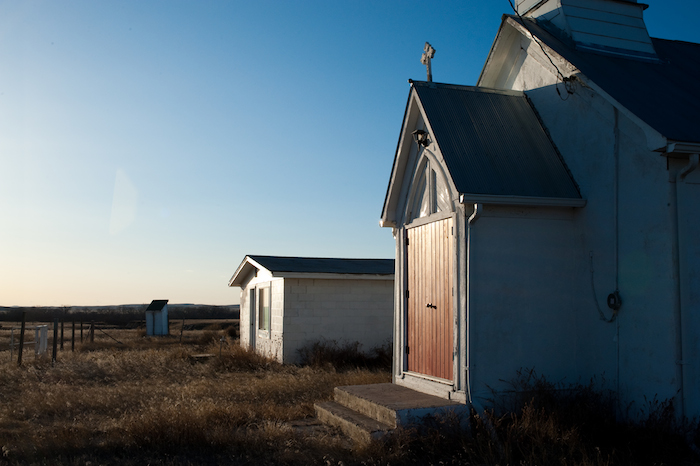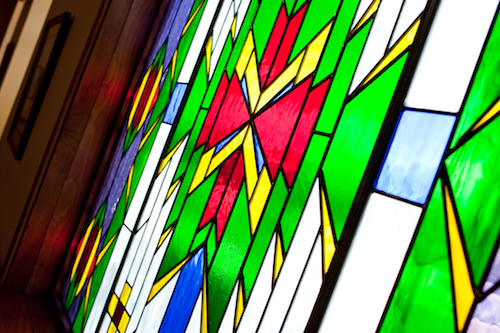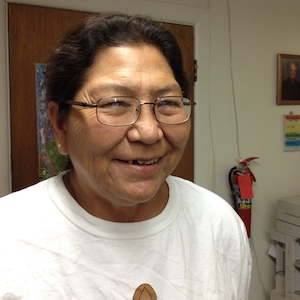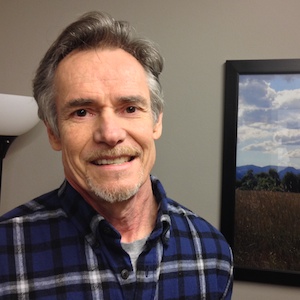Building a Lakota Catholic Parish
Native Lay Ministers Becoming Leaders in the Church
posted on January 6, 2014
 Charles McGaa had been teaching in Red Cloud’s elementary school for over ten years when he had an awakening. He loved his students, and even served as an assistant principal to help with school administration. But when he began teaching a religion class, he started to feel a powerful pull toward a different kind of work.
Charles McGaa had been teaching in Red Cloud’s elementary school for over ten years when he had an awakening. He loved his students, and even served as an assistant principal to help with school administration. But when he began teaching a religion class, he started to feel a powerful pull toward a different kind of work.
“I really liked teaching religion, and I started to feel a stronger and stronger desire to work in the church,” says Charles. “At the time, though, I wasn’t sure how I could do that.”
In the years that followed, Charles found his way. He has become one of the longest-serving Lakota lay leaders in Red Cloud’s pastoral ministry program, a network of churches and community centers serving more than 800 families across the Pine Ridge Reservation. Red Cloud was founded as a Catholic mission in 1888, and Jesuit priests and Franciscan sisters once managed the parish almost exclusively. But today, Lakota lay ministers like Charles frequently lead the work of supporting parishioners, providing religious education, working with youth and offering social services to those in need.
Charles now serves as parish life coordinator at Sacred Heart Church, the largest among the reservation’s six congregations. He has a long history at Sacred Heart—his own parents were married there in 1939—and a deep connection to the community. On any given day, you can find him organizing classes, coordinating social outreach programs and visiting the homebound and hospitalized. And although he is not an ordained minister, he says that is exactly the way he wants it.
“I studied for a while in the deacon program, but when it came time to be ordained, I decided instead to finish the program as a lay minister,” says Charles, explaining his desire to remain an equal to each and every parishioner. “In the church’s early history, all who were baptized were recognized as part of a common priesthood—but today, only ordained ministers can provide certain services. I wanted to stay in the realm of what all people are called to do in the church—what every person is invited to do.”
 Meeting Community Needs Across the Reservation
Meeting Community Needs Across the Reservation
Fewer Jesuits have come to the reservation to oversee the parish’s work in recent decades—a fact that reflects an overall decline in the number of Jesuits across the country. Church leaders like Sister Connie Schmidt, SSND, who has been an educator and pastoral coordinator at Red Cloud for over 15 years, believes the parish’s future on Pine Ridge now depends on the involvement of committed Lakota lay ministers. Native leaders like Charles, she says, can ensure the building of a more “inculturated” church—one that honors and integrates Lakota tradition and culture with Catholic practice and faith.
“There are many reasons why we need greater involvement of Lakota lay leaders on the reservation—but a primary reason is that this is really their church. It belongs to the Lakota people here, and it’s very important that they be the ones to minister to one another,” says Sister Connie.
“For centuries the church has operated vertically, so there was always someone at the top and someone at the bottom. But if we look at the church’s earliest beginnings, it was much more circular, with people coming together as equals to hear the Word of God and to break bread with one another. We’re trying to envision the Lakota church that way.”
To nurture more Native leaders in the parish community, Sister Connie has been working closely with Veronica Valandra, Red Cloud’s first Lakota pastoral coordinator, to design and launch a new training program for Lakota lay ministers. She hopes it will draw out and engage a new wave of Lakota Catholics who want to lead the parishes into the future, and combat some of the reservation’s grave social and economic challenges through the church’s work.
“There are these tiny, isolated towns all across the reservation, and our churches there become a center for those communities. And while we are Catholic, all are invited—it’s about creating a safe space for people to gather together and experience spirituality. Many people on the reservation face extreme challenges from the poverty they live in—you just want to put your arms around them and tell them to keep going.”
Lakota lay minister Angie Stover, who has been a parishioner at Sacred Heart since she was 11 years old and today serves as its pastoral associate and office manager, says the work of building a stronger and safer community is at the core of both her Catholic faith and her Lakota identity.
 “Our Lakota culture tells us our actions should always be for the people, to help our people become more healthy, independent and to live with dignity,” she explains. “In the same way, baptism calls us into the community, and to constantly ask ourselves how we are contributing to the community.”
“Our Lakota culture tells us our actions should always be for the people, to help our people become more healthy, independent and to live with dignity,” she explains. “In the same way, baptism calls us into the community, and to constantly ask ourselves how we are contributing to the community.”
Although it is often painful work, Sister Connie explains that one of the greatest needs lay leaders help to meet is providing wakes and funerals for those who have lost a loved one. During the parish’s toughest weeks, when there are multiple funerals, pastoral staff will drive thousands of miles crisscrossing the reservation to minister to grieving families. Charles says leading those services is difficult, but it represents one of the most rewarding parts of his work.
“I have a sense that I’m doing the right thing when I’m helping people with their bereavement. I preside at many funerals, and I’ve seen how that can be a poignant time in people’s lives,” Charles shares. “I’ve seen how I can bring comfort to people, and that’s one of the things I’ve been working to develop within me—to bring the healing of the church to people who are in grief. It’s an extraordinary opportunity and responsibility.”
Building Bridges Between Lakota and Catholic Spirituality
With Native lay leaders at the forefront of parish work, Lakota and Catholic spiritual practices are becoming more intertwined. At a recent mass held to celebrate Red Cloud’s 125th anniversary, the sounds of a Lakota drum group resonated through the chapel as hymns were sung in both English and Lakota. As Sister Connie explains, integrating Native culture into Catholic worship is another gift Lakota lay leaders bring to the church.
“That is the hope of this work—that with bringing more Lakota lay ministers forward, that their culture will be a part of their ministering,” she says. One of her current goals is to recruit and hire a new religious educator who understands both Catholic faith formation and Lakota culture, to ensure both are represented.
Charles believes that integrating Lakota cultural practices with Catholic traditions will ultimately bring more Native leaders back into the church.
 “Historically, the progression of western civilization overrode and devalued anything Lakota. Now the church is bringing it back,” says Charles. “I think it gives people a strong sense of their Lakota identity, if they see something in the Lakota tradition embraced by the church.”
“Historically, the progression of western civilization overrode and devalued anything Lakota. Now the church is bringing it back,” says Charles. “I think it gives people a strong sense of their Lakota identity, if they see something in the Lakota tradition embraced by the church.”
Growing up on the reservation, Angie shares that, at certain times in her life, she struggled with reconciling being both Catholic and Native American. During the Civil Rights Movement in the 1970’s, she reconnected with her Lakota spirituality. But as her children grew up, she began taking classes and workshops on Catholic faith, and eventually learned she could claim both her Catholic and Lakota identities.
“It’s an ongoing process for a lot of people here, to reconcile being Native American and being Catholic. In the past indoctrination was so severe, and people felt you had to dispel being Native American. People are still suffering from that, and they need healing,” she shares. “I believe all they have to do is claim who they are as Native American, to understand that is God’s gift to us, including our Native spirituality. It doesn’t make any sense that you can’t claim that and also choose to practice another faith.”
Charles agrees, and explains that there is a long history of Lakota Catholics on the reservation who valued both spiritualities—and were honored as leaders.
“I think when you look back at the history of the church on the rez, at the beginning there were Lakota men who were catechists. They took leadership roles in the parishes—because areas on the reservation were so remote and transportation was limited, they took charge of the parishes and only once a month a priest would come. Catechists helped with burials, taught the young, and the church was strong at that time. Many people don’t know that Black Elk, the famous Lakota medicine man, was also a practicing Catholic and became a catechist,” he says. “If we look back at those models, there’s a foundation there. I think for Lakota people to see people from their own communities leading the church, that will do a lot to strengthen involvement in the church. People can really relate, and envision themselves as leaders as well.”
All Content, ©Red Cloud Indian School, 2014
